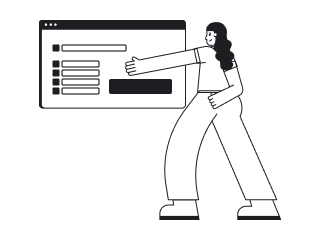Low-code platforms can rightfully be called industry game-changers. They significantly cut the time for development, and, consequently, overall development costs.
Low-code is like the pre-cut salad ingredients in a supermarket. You can use them to skip the tedious prep and create your own creative salads. Just replace carrots with code.

As a SaaS design agency that has recently worked on a low-code platform design, we can say that many low-code platforms created by developers with developers in mind are not very user-friendly. Smooth UX design can be a decisive competitive advantage in this niche. So if if you are considering creating one yourself, let’s discuss it from a design perspective.
But first, a bit about low-code products business.
What is low-code platform?

Low-code is an approach that simplifies software development by using visual interfaces and pre-built code components instead of coding everything from scratch. Low-code benefits include reduced costs, fastertime-to-market, and a more accessible development process for non-tech people.
A low-code platform is a product that provides tools for low-code development. With the help of such platforms, one can create a low-code website or a whole SaaS product. The most common low-code examples are CRM and data analysis tools. And you might have heard about Kissflow and Appian – these are low-code platforms.
Using low-code platforms, you can launch an MVP fast without having specific tech skills or test a new idea or feature. Overall, it is about making product development less time-consuming and more user-friendly.
Why low-code?
Low-code platforms are one of the hottest B2B SaaS trends. According to Straits Research, the global low-code development platform market is expected to reach an estimated value of $148.5 billion by 2030, growing at a CAGR of 27.8% from 2022 to 2030.
The amount of costs low-code can save for tech development is enormous. Along with no-code, it can truly revolutionize the field, and that’s why it’s worth jumping on this train before the competition gets fierce.
What is low-code architecture?

Low-code architecture is the foundation of a software development platform that makes it easy to create applications with minimal manual coding. If you think of low-code as LEGO blocks, low-code architecture would be the science of building with them (it may be easier but has some specifics, too). Good low-code architecture is designed to work for various types of apps and ensures security, scalability, and a good user experience.
Low-code design. Why should we care?
There is a discussion on whether low-code and no-code tools steal programmers' jobs, but what about designers? Of course, with more streamlined product development, founders have many possibilities of creating a prototype without a designer.
It is a great option to test your idea fast. From our experience, founders do that, but once they are ready to work on an MVP, they come to work with our designers.
So, low-code does reduce the overall need for design work. But there are some situations where you need a UI/UX expert, and here they are:
- Users have difficulty completing their tasks, and the product needs to be reviewed for possible improvements in user experience.
- New elements created with low-code or no-code tools must be adapted to fit the overall design system.
- A product made with pre-made blocks lacks individuality and needs some visual identity to stand out from the competition.
So ultimately, designers still have some work to do even with low-code (just like programmers). That’s why let’s dive deeper and see what exactly their job is.
When talking about low-code design, there might be some ambiguity. I’d like to define three different situations:
- designing a low-code platform
- designing an app developed using low-code tools
- designing the look of low-code modules inside of a low-code platform
If designers did a good job in the third situation, the job of designers working on an app built with the low-code platform would be much easier. If we had to define some general rule for working with low-code design, it would be: make it more universal and less original. It doesn’t mean anything bad. For many digital products, building a product that looks like the others actually means a better user experience.
As a SaaS design agency, we have some experience designing low-code platforms. Here is the most common challenge we faced with these products.
Different levels of user expertise
Low-code tools have two different types of users. On one side, there are seasoned developers who want to save some time with low-code tools, and on the other side, there are non-developers who need those tools to be able to create a product without hiring a team of engineers.
From the design standpoint, these two groups need to be approached differently. Developers are a particular crowd: they like their tools to be highly customizable and they don’t get easily overwhelmed by having lots of data and menus on one screen. Indeed, they prefer to have everything available at one click rather than have it hidden in the menu.
The second group of users will likely be confused by the interface that seems easy and clear to the first group. But however user-oriented you want your design to be, the absolute majority of products won’t create different designs for different types of users. So, we have to find the middle ground.
Here are some of the tips that will help you satisfy both audiences:
- Tooltips. Small question marks with explanations can help those unfamiliar with all the terms without cluttering the screens.
- Templates and customization. Inexperienced users can choose a pre-made template, while those who need a tailored solution should have the necessary editing tools.
- Easily accessible tech support. Hiding the support contacts is popular in some products, and it’s often reached by designing it hard to find. However, if a product needs to attract less experienced users, this “trick” has to be avoided.
And in some cases, it is possible to separate user flows for different types of users. We have an on-point example for that.
How we designed a low-code platform to fit two different types of users
Stradigi AI, a leading North American SaaS AI business platform provider, came to us for a redesign of their product, Kepler, a low-code AI platform.
One of the main challenges was already mentioned above: the platform had to have ML algorithms accessible to non-tech users, while tech-savvy folks could edit the code the way they need to.
To analyze users’ needs, we conducted several interviews with people already using Kepler. To optimize the user flow for creating and training the ideal machine learning model, we created separate tabs catering to two distinct user groups.
- The first tab is tailored for tech-savvy users, specifically data engineers responsible for model training. They can upload training data, monitor errors, study prediction statistics and graphs, and fine-tune the model for peak accuracy.
- The second tab is designed for business users. These users are primarily concerned with the results provided by Kepler and thus need a minimal amount of details of data training. They can upload the requisite files and use the outputs without delving into the technicalities.

As a result, it simplified user flow and gave each type of users what they needed, and we were happy to make low-code tools a bit more accessible to non-tech people. If you want to see what the final product looks like, check out our case study.
To sum up
Designing low-code platforms can be challenging, just like any other product. What helped us when designing the Kepler platforme, we didn’t follow some low-code design handbook. Instead, we followed good old rules of the design process: run competitive analysis and user research to find the things that needed improvement.
Yet, the experience of designing a low-code platform taught us many new things about this type of product and even inspired us to write the article you’re reading right now. Now, we are curious to work with other similar products.
If you are looking for designers who have experience working with low-code platforms, just text us, and we’ll be happy to help you!













